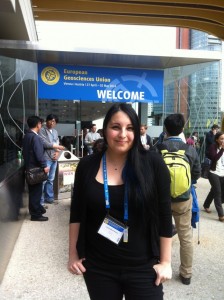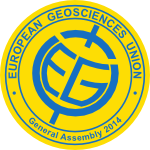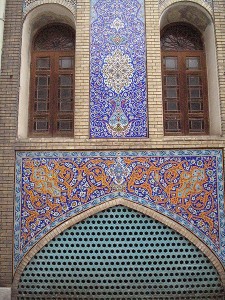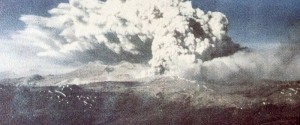Today I had the great pleasure of interviewing Cindy Mora-Stock.
It was a great success as I was finally able to put a face to the twitter handle that I’ve been following almost from my first days on Twitter. What’s even better is that I can safely say I’ve come away from the interview having made a new friend, as Cindy and I hit it off straight away. The final bonus of choosing to do some 10 minute interviews at EGU 2014 is that I’m actually speaking to people face to face, rather than arranging the interviews via email, you simply can’t beat having a conversation with someone!
Cindy is presenting her research on Friday morning, 10.30-12.30 at session GMPV37 Volcano monitoring with instrument networks: novel techniques, observations and interpretations – Blue poster hall B779. Cindy has also published a number of papers, details of which can be found here.
For these live interviews from EGU2014, I’ve introduced a new question regarding the interviewee’s experience of the conference. Remember, I’m on the look out for people to interview, so PLEASE get in touch via the blog or on twitter (@lauRob85) if you’d like me to feature you and your research!
- You are: Cindy Mora-Stock
- You work at: Christian-Albrechts-Universitä… · Department of Geosciences
- Your role is: PhD Researcher
Q1) What are you currently working on?
Seismicity and velocity structure of the Villa Rica Volcano, southern Chile.
Q2) What is a typical day like for you?
I would say there is never a typical day. As soon as I get into work I catch-up with colleagues and friends in the office. At the start of every week I like to make a To-Do list for that week and I set out to accomplish something from my To-Do list every day: that might be a figure, a section of code or writing something up. My day tends to end between 6-7pm dependant on how successfully I’m getting through the To-Do list.
Q3) What has been the highlight of your career so far? And as an early stage researcher where do you see yourself in a few years time?
The answer to this question has to be two fold.
Firstly, having had the opportunity to communicate science to people who may have limited scientific knowledge, through studying and researching geosciences.
Being able to visit and get to know places off the beaten track and the scenery of those locations is what really ignites my passion for science.
In a few years time, I’d like to be working at a University or as a researcher at a volcano observatory. Whatever I end up doing, I’m sure I want to continue to be involved with science through science communication, maybe through working in museums or a career in science communication.
Q5) To what locations has your research taken you and why?
I have two favourites: 1)The Chile desert – although I’m not a big fan of places without shade, the experience of being in a place without water, mobile phone signal, water or shelter makes me ask myself the question: If something happened to me out here, what would I do? The colours, structures and geology you can observe in the desert are incredible! 2) A national park in Chile (I can’t quite remember the name, sorry!). There is an amazing view point where you overlook a forest burnt down by a volcanic eruption, but in between the skeletal looking trees you can see new trees growing. That place makes me realise just quite insignificant humans are and how planet Earth would continue on regardless if the human race where to die out.
Q6) Do you have one piece of advice for anyone wanting to have a career similar to yours?
Don’t lose sight of the bigger picture! What your research focuses on might seem insignificant at times, but there is someone out there who does care and to whom your research matters. Motivation is really important!
Q7) What is your highlight of attending the EGU 2014 Assembly?
The opportunity to meet up with old friends and colleagues who work at other institutions and countries as well as meeting and networking with new people.
The short-courses and workshops are also a highlight for me. A couple of years ago I attended a Fourier Series short-course which taught me more in a couple of hours than I learnt during a whole module at University!
Q8) If you could invent an element, what would it be called and what would it do?
Transportanium – an element that would allow tele-transportation. It is important that it is good enough at its job that your body’s atoms aren’t chaotically rearranged once you reach your destination, so that you are still yourself.
When not studying volcanoes and their assocaites seismicity, Cindy can be found head banging at a metal music festival or bar! You can contact Cindy via twitter @Cindy_Sismologa




